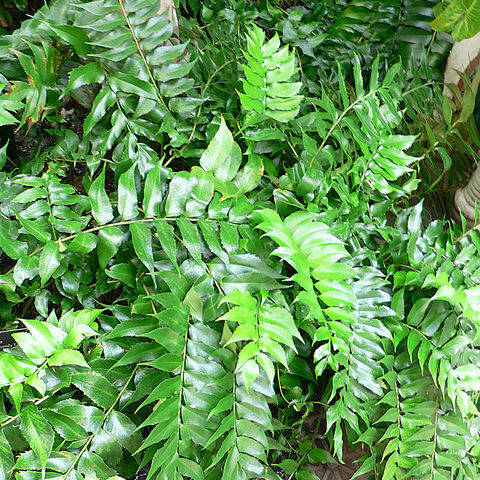Plants terrestrial or on rock. Stems erect or ascending, stolons absent. Leaves monomorphic, evergreen. Petiole ± 1/2--3/4 length of blade, base not swollen; vascular bundles more than 3, arranged in arc, ± round in cross section. Blade oblong-lanceolate, 1-pinnate with pinnae not lobed, distal pinnae only slightly smaller, blade ending in basally lobed pinna ± similar to lateral pinnae, papery or somewhat leathery. Pinnae not articulate to rachis, segment margins crenate to spinulose, sometimes also coarsely dentate; proximal pinnae not reduced, petiolulate, equilateral or somewhat inequilateral with acroscopic base more developed; costae adaxially grooved, grooves continuous from rachis to costae; indument of filiform scales abaxially, absent adaxially. Veins elaborately anastomosing, areoles formed with 1--3 included veinlets. Sori in 2 or more rows between midrib and margin, round. Indusia peltate, persistent or caducous. Spores brown, with inflated folds or wings. x = 41.
Terrestrial or lithophytic ferns. Rhizome short, erect or decumbent, often stout; stipe bases persistent; scales large, entire but becoming erose. Fronds tufted, monomorphic. Stipe densely scaly. Lamina pinnate; apical segment entire or irregularly pinnatifid. Pinnae falcate, acuminate, coriaceous; margins entire or dentate; veins free (not in Australia) or regularly anastomosing with included free veinlets or casually anastomosing without included free veinlets. Sori rounded, in 2-several rows on each side of the costa; indusium rounded, peltate. Spores globose to ellipsoidal, monolete.
Terrestrial ferns. Rhizomes short, ± erect, very scaly. Fronds usually 1-pinnate, scaly at least on stipes; veins free or anastomosing. Sori round, borne on veins, in 2 or more rows either side of midrib, usually protected by peltate indusia. Spores monolete.

